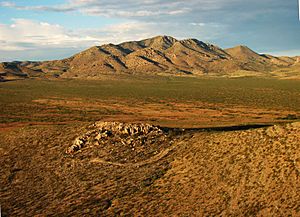Battle of Mount Gray facts for kids
Quick facts for kids Battle of Mount Gray |
|||||||
|---|---|---|---|---|---|---|---|
| Part of the Apache Wars, American Civil War | |||||||
 Mount Gray looking west from the Animas Valley. |
|||||||
|
|||||||
| Belligerents | |||||||
| Apache | |||||||
| Commanders and leaders | |||||||
| unknown | |||||||
| Strength | |||||||
| 59 | ~250 | ||||||
| Casualties and losses | |||||||
| none | 21 killed | ||||||
The Battle of Mount Gray was an important fight during the Apache Wars. These wars were a series of conflicts between the United States Army and various Apache Native American groups. The battle happened on April 7, 1864, near Mount Gray. In this battle, a group of U.S. soldiers from the California Column attacked a much larger group of Chiricahua Apache warriors. The soldiers managed to defeat the Apache force.
Contents
Why the Battle Happened
The Civil War and the California Column
The American Civil War started in 1861. During this time, a part of the American Southwest was called Confederate Arizona. To take control of this area and help the Union army in New Mexico Territory, the Union government created a special group of volunteer soldiers from California. This group was known as the California Column.
The California Column traveled about 900 miles between 1862 and 1863. Along their long journey, they built or took over several military camps and forts. When the main group moved on, some soldiers stayed behind to protect these posts. One of these important posts was Camp Mimbres.
The Apache Raid and the Expedition
On March 15, 1864, Apache warriors raided a group of farm animals at Cow Springs. They stole many animals. By March 27, the soldiers at Camp Mimbres learned about the raid.
Captain James H. Whitlock decided to lead a mission to get the stolen animals back. His group included 46 soldiers from the 5th California Infantry and 10 soldiers from the 1st California Cavalry. A few local scouts also joined them to help track the Apache trail.
They headed towards Stein's Peak in the Sierra Bonita Mountains. There, they found an Apache trail that led north into the San Simon Valley. After several days of marching, the trail turned west. They followed it to the base of Mount Gray, which is now in Hidalgo County, New Mexico.
The Battle of Mount Gray
Finding the Apache Camp
On April 7, around 4:00 AM, Captain Whitlock and his soldiers were marching through the foothills of Mount Gray. Whitlock saw campfires in the distance. He immediately guessed that it was an Apache camp.
Whitlock quickly moved his soldiers closer to the camp. About 250 Apache warriors were resting there with the stolen animals. Whitlock decided to split his soldiers into a few smaller groups. Their plan was to surround the camp and attack when the sun came up.
The Attack
As the sun rose, the American soldiers began their attack. Captain Whitlock led the charge directly into the Apache camp. The Chiricahua Apache warriors fought back for over an hour. Eventually, they had to retreat up the mountain.
Once the Americans had control of the camp, they set fire to the Apache homes, called wickiups. They also destroyed about 300 pounds of dried mescal. Mescal was a very important food source for the Apache people.
While the soldiers were burning the mescal, about 30 Apache warriors who had retreated turned back. They attacked the soldiers, trying to stop them from destroying their food. However, the soldiers fired their rifles effectively and drove the Apache warriors away.
Results of the Battle
The battle ended with 21 Apache warriors killed on the field. Others were wounded but managed to escape. The American soldiers captured 45 horses and mules. No American soldiers were killed or wounded in this battle.
Aftermath
The Battle of Mount Gray was one of the most important fights between the California Column and the Apache. Like an earlier battle called the Battle of Apache Pass, the American soldiers were outnumbered. However, they still managed to defeat a larger group of experienced Apache warriors.
Later, Whitlock Valley and the Whitlock Mountains were named after Captain Whitlock to honor him.

